The Intel Core i9-9990XE Review: All 14 Cores at 5.0 GHz
by Dr. Ian Cutress on October 28, 2019 10:00 AM ESTCPU Performance: Encoding Tests
With the rise of streaming, vlogs, and video content as a whole, encoding and transcoding tests are becoming ever more important. Not only are more home users and gamers needing to convert video files into something more manageable, for streaming or archival purposes, but the servers that manage the output also manage around data and log files with compression and decompression. Our encoding tasks are focused around these important scenarios, with input from the community for the best implementation of real-world testing.
All of our benchmark results can also be found in our benchmark engine, Bench.
Handbrake 1.1.0: Streaming and Archival Video Transcoding
A popular open source tool, Handbrake is the anything-to-anything video conversion software that a number of people use as a reference point. The danger is always on version numbers and optimization, for example the latest versions of the software can take advantage of AVX-512 and OpenCL to accelerate certain types of transcoding and algorithms. The version we use here is a pure CPU play, with common transcoding variations.
We have split Handbrake up into several tests, using a Logitech C920 1080p60 native webcam recording (essentially a streamer recording), and convert them into two types of streaming formats and one for archival. The output settings used are:
- 720p60 at 6000 kbps constant bit rate, fast setting, high profile
- 1080p60 at 3500 kbps constant bit rate, faster setting, main profile
- 1080p60 HEVC at 3500 kbps variable bit rate, fast setting, main profile
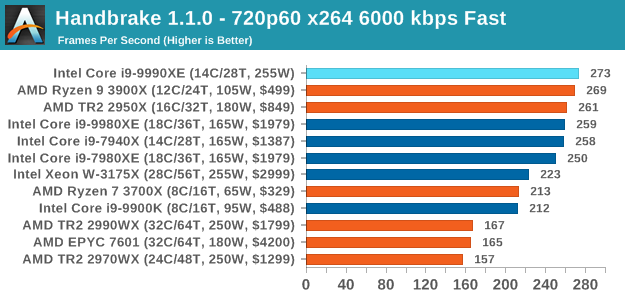
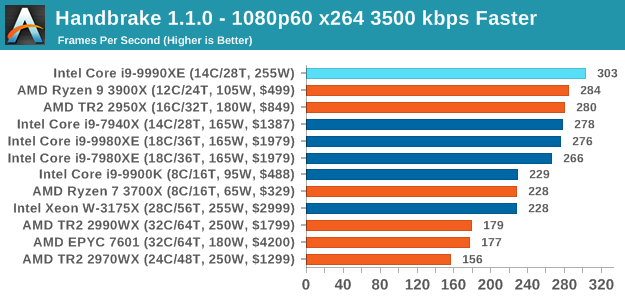
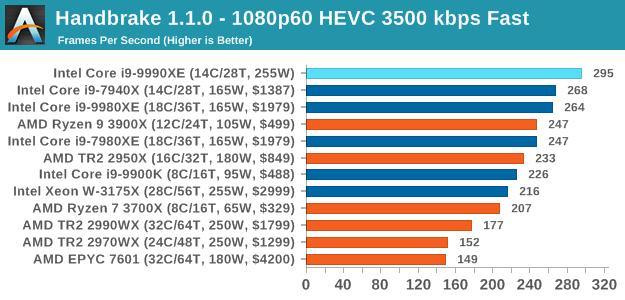
Our encoding tests require a good balance of cores and frequency, and the 5.0 GHz 14-core hardware easily pulls ahead of the 7940X, and shows that having 28 cores isn't always a good thing.
7-zip v1805: Popular Open-Source Encoding Engine
Out of our compression/decompression tool tests, 7-zip is the most requested and comes with a built-in benchmark. For our test suite, we’ve pulled the latest version of the software and we run the benchmark from the command line, reporting the compression, decompression, and a combined score.
It is noted in this benchmark that the latest multi-die processors have very bi-modal performance between compression and decompression, performing well in one and badly in the other. There are also discussions around how the Windows Scheduler is implementing every thread. As we get more results, it will be interesting to see how this plays out.
Please note, if you plan to share out the Compression graph, please include the Decompression one. Otherwise you’re only presenting half a picture.
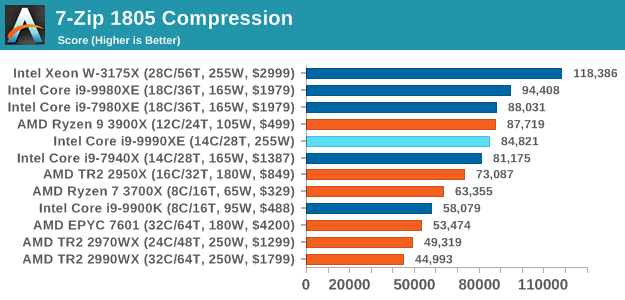
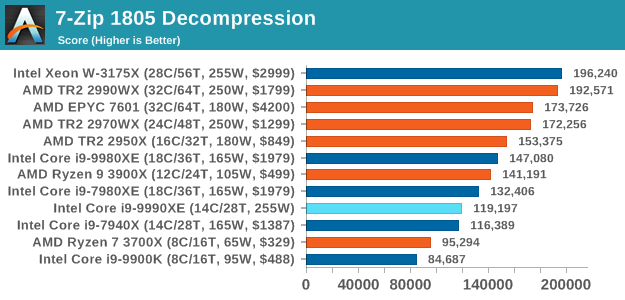

This is where having 28-cores helps, as the extra frequency can't beat some extra cores.
WinRAR 5.60b3: Archiving Tool
My compression tool of choice is often WinRAR, having been one of the first tools a number of my generation used over two decades ago. The interface has not changed much, although the integration with Windows right click commands is always a plus. It has no in-built test, so we run a compression over a set directory containing over thirty 60-second video files and 2000 small web-based files at a normal compression rate.
WinRAR is variable threaded but also susceptible to caching, so in our test we run it 10 times and take the average of the last five, leaving the test purely for raw CPU compute performance.
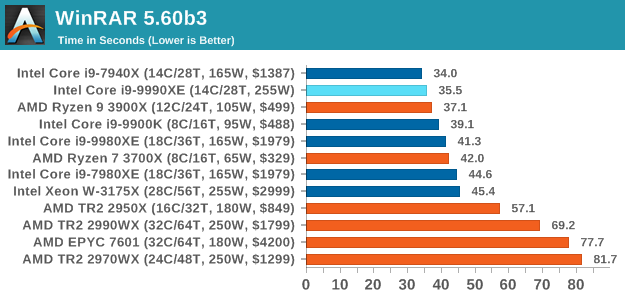
WinRAR is one of our variable threaded tests, so here a mix of cores and frequency helps. Interestingly enough, the 9990XE despite with the higher frequency is slightly slower than the 7940X - this might be a function of the test getting too fast, or the fact that the extra power needed to drive up the cores to peak frequency might be causing additional delays with all the small files.
AES Encryption: File Security
A number of platforms, particularly mobile devices, are now offering encryption by default with file systems in order to protect the contents. Windows based devices have these options as well, often applied by BitLocker or third-party software. In our AES encryption test, we used the discontinued TrueCrypt for its built-in benchmark, which tests several encryption algorithms directly in memory.
The data we take for this test is the combined AES encrypt/decrypt performance, measured in gigabytes per second. The software does use AES commands for processors that offer hardware selection, however not AVX-512.
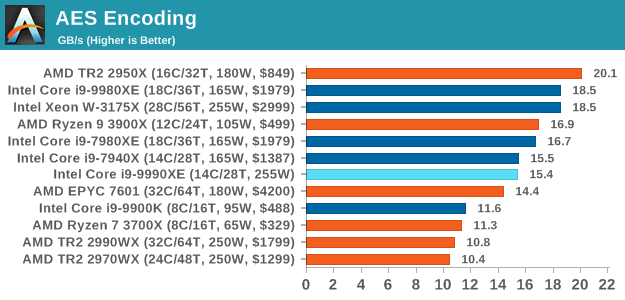










145 Comments
View All Comments
Sivar - Monday, October 28, 2019 - link
Why such an angry statement?14 is a very respectable number of cores. 14 at 5GHz is a world exclusive.
I wouldn't even call this a product -- more of a hand-picked specialty part auction, which is perfectly reasonable (if uncommon) for any manufacturer to do. The fact that the parts sold indicates the demand is there. Why ignore the demand?
Spunjji - Wednesday, October 30, 2019 - link
The fact that they sold very few of them indicates that the demand is barely there.FunBunny2 - Monday, October 28, 2019 - link
"Stories of companies spending 10s of millions to implement line-of-sight microwave transmitter towers to shave off 3 milliseconds from the latency time is a story I once heard. "There was reporting, mainstream source (Lewis: https://www.telegraph.co.uk/finance/newsbysector/b... that a broker(s) installed a fiber line from the Chicago office to an exchange in NJ.
“It needed its burrow to be straight, maybe the most insistently straight path ever dug into the earth. It needed to connect a data centre on the South Side of Chicago to a stock exchange in northern New Jersey. Above all, apparently, it had to be secret," Mr Lewis said.
bji - Monday, October 28, 2019 - link
I call BS on that story. Why would you spend hundreds of millions (it must have cost at least that right?) to dig a straight 800+ mile tunnel between Chicago and NYC to get a 13 ms latency just so you could be destroyed by offices in NYC with 5 ms latency. Makes no sense. Your only choice is to move physically close to the source, if lowest latency is the winner then that's the only way to get it and be competitive.Authors happily embellish existing stories, misrepresent details, and just plain old make sh** up to sell books. And then news outlets happily garbage-in, garbage-out these stories to get hits. I'm pretty sure that's what happened with that "story".
eek2121 - Monday, October 28, 2019 - link
Companies have done it. Hell years ago I INTERVIEWED with a company that did it. It would blow your mind to find out what the financial folks will do to accelerate trading. A large portion of stock market trades are automated and driven by machine learning or predictive algorithms. How do I know, that position I interviewed for years ago (2003) was for a software developer for such an algorithm. I didn't get the job, because I didn't have the skills they were looking for at the time, but we did have a very interesting conversation about how their platform worked. It's fascinating how finance pushes everything forward.FunBunny2 - Monday, October 28, 2019 - link
" It would blow your mind to find out what the financial folks will do to accelerate trading."yes, yes it would - here: https://www.marketplace.org/2019/10/07/fight-nyse-...
bji - Monday, October 28, 2019 - link
Yes, I believe that those companies probably often spend lots of money to buy competitive advantages. I am simply stating that they'd not be buying a competitive advantage here (since the real competition is based in NYC had has an insurmountable advantage - the laws of physics not letting signals travel between Chicago and Wall St. faster than 13 ms) so they wouldn't spend the money. They would spend money buying an actual competitive advantage, i.e. offices in NYC.mode_13h - Tuesday, October 29, 2019 - link
> Why would you spend hundreds of millions (it must have cost at least that right?) to dig a straight 800+ mile tunnel between Chicago and NYC to get a 13 ms latency just so you could be destroyed by offices in NYC with 5 ms latency. Makes no sense. Your only choice is to move physically close to the source, if lowest latency is the winner then that's the only way to get it and be competitive.When something doesn't seem to make sense, maybe the error is in your understanding of the situation. Did you ever consider that there are financial markets outside of NYC, and that some people might be trading between markets, or using signals from one market to inform trades in others?
Joel Busch - Tuesday, October 29, 2019 - link
This one is easy to answer, because there are two stock exchanges in play. NYSE in New York and CHX in Chicago. If you can send information from one exchange to the other quicker than others then you have an opportunity for arbitrage.One of my professors is Ankit Singla, he works on c-speed networking, he cited this paper in class https://doi.org/10.1111/fire.12036
They say for example:
"Our analysis of the market data confirms that as of April 2010, the fastest communication route connecting the Chicago futures markets to the New Jersey equity markets was through fiber optic lines that allowed equity prices to respond within 7.25–7.95 ms of a price change in Chicago (Adler, 2012). In Au-gust of 2010, Spread Networks introduced a new fiber optic line that was shorter than the pre-existing routes and used lower latency equipment. This technology reduced Chicago–New Jersey latency to approximately 6.65 ms (Steiner, 2010; Adler,2012)."
I don't have the time to read the whole paper right now, I'll just trust my professor here. If there is actually something wrong with their methodology then I think the world would like to hear it.
rahvin - Monday, October 28, 2019 - link
<<“It needed its burrow to be straight, maybe the most insistently straight path ever dug into the earth. It needed to connect a data centre on the South Side of Chicago to a stock exchange in northern New Jersey. Above all, apparently, it had to be secret," Mr Lewis said>>That's just a bunch of hogwash. You couldn't dig a straight line from Chicago to Jersey. It's just fancy sounding hogwash meant to convince those without the logic or background to see it for the hogwash it is. It's no more true than grimm's fairy tales.